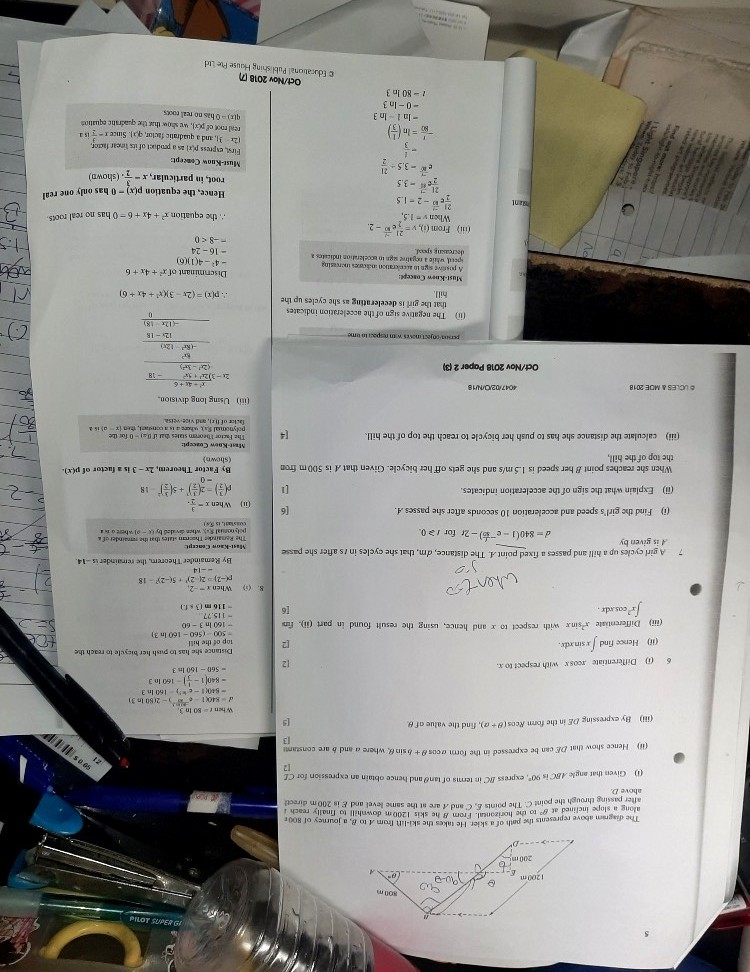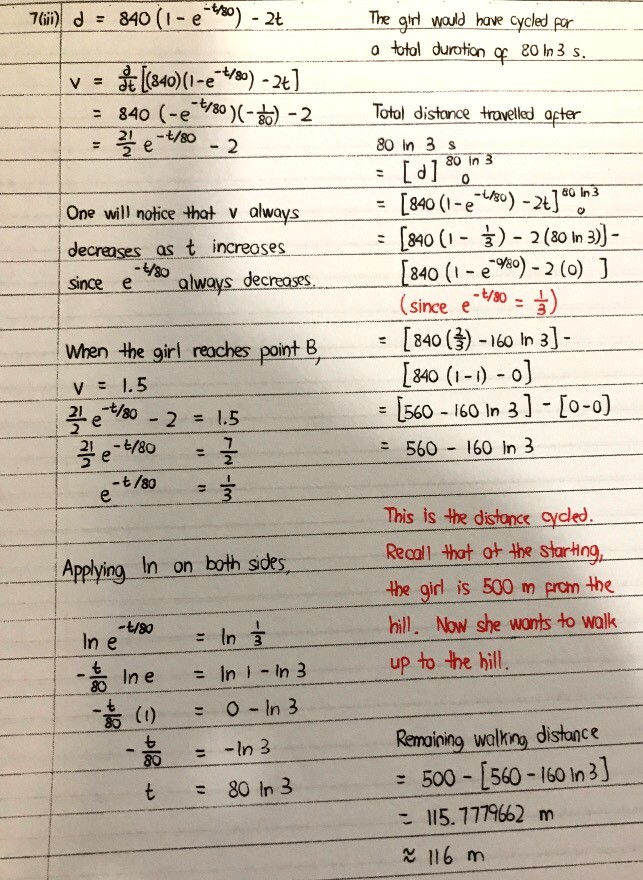Ask Singapore Homework?
Upload a photo of a Singapore homework and someone will email you the solution for free.

Question
secondary 4 | A Maths
2 Answers Below
Anyone can contribute an answer, even non-tutors.

Hello can someone explain the answer for 7(iii)?
Now, we would like to solve this equation, but x is in the power, and 1/3 is not a power of e. The only way we can solve for x is if we can bring down the x from the power to the base. But how do we bring down the power?
The technique in solving such equations is to apply a logarithm to the same base on both sides of the equation. Any base which is more than 1 works, but I choose log to base e, which is simply written as ln.
Then, we apply ln to both sides of the equation (remember if we perform the same operation to both sides of an already equal equation, the resulting new equation is also equal).
ln e^-t/80 = ln (1/3)
Recall from your power rule of logarithms that we can bring the power down (this is the crucial step to solve this question).
So, -t/80 * ln e = ln (1/3)
But I choose specifically base e because ln e is nicely equal to 1.
So, -t/80 = ln (1/3)
Multiplying both sides by -80,
t = -80 ln (1/3)
We put this inside the calculator.
5 is not a nice power of 3, yet we know that 3^1 = 3 and 3^2 = 9. So the power of x must be between 1 and 2, but what can it be?
This is when applying logarithms to both sides work.
We choose base 10 or base e because these are the only two bases which a typical calculator is programmed to calculate.
Applying lg (logarithm to base 10) on both sides,
lg 3^x = lg 5
The bringing down the power property of logarithm is the reason why we can solve this equation, because once the power is brought down, it becomes regular multiplication and addition.
x lg 3 = lg 5
Now we can just solve the rest like algebra.
x = lg 5 / lg 3
And the calculator does the job.
Let me know if you still have difficulties with the ln part or any other part of the question and I will explain them more clearly.
The initial distance from the starting point A to the end point (not labelled) is 500 m, as provided in the question.
The girl would have probably started at the greatest speed and slowed down until 1.5 m/s before getting off the bicycle. The speed remains positive so there is no change in direction and we do not have to worry about any direction change.
The value of t that we have found earlier is needed to compute the distance travelled from the start (at point A) until the point when the speed is 1.5 m/s. Remember that the motion of the girl is defined in the equation and is not your typical “the girl moves at a constant speed of ...” question so we cannot use speed * time here.
This distance is calculated to be approximately 384 metres.
The remaining distance, which is 116 metres, must be the walking distance.
We recognise the equation v = 21/2 * e^(-t/80) - 2 as a graph which always decreases as t increases (a property of graphs of y = e^-x).
In other words, the girl’s speed always decreases as the time passes. The girl’s final speed is 1.5 m/s, meaning that the girl’s starting speed must have been more than this. Since the speed always decreases but it stops at 1.5 m/s, the speed will never get to zero.
In such cases, where we are confident that v cannot cross the zero point, there will be no turning of directions, and hence we can calculate the results safely.
In actual fact, if the story goes that the girl continues cycling for a long time (and the hill is unlimited distance), it is well possible that the velocity becomes zero (because the lowest possible value of 21/2 * e^(-t80) is 0 and 0 - 2 is -2) and the girl changes direction. In that situation, there is a turning point and we must consider it.
As for why it’s a subtraction, the girl starts 500 m from the top of the hill and the girl moves “towards” the hill, thereby decreasing the distance between her and the hill. Hence, it must be a subtraction.
The starting 500 m has nothing to do with the distance travelled by the girl at the start. Basically, the story is such that the girl cycles and walks up a hill for a total of 500 m. The girl first cycles up to the point where t = (our calculated value) before walking the remaining distance.
It’s like saying, I am running a marathon 42 km long, and I first ran at a speed of 8 km/h for 2.5 hours and walked the remaining distance, what is the distance I have to walk to complete the race? Well, I have to subtract the 20 km running distance from the 42 km marathon distance.
See 2 Answers
Of course, you will need to know how the graph of y = e^-x looks like, since it is on your syllabus. However, for the time being, I will plot them for you to have a better idea of the question.
The red graph is the graph of v = -21/2 * e^(-t/80) - 2 which is basically the velocity graph of motion.
The girl stops cycling when t = 1.5 m/s, indicated by the blue horizontal line.
The girl stops cycling when t = 80 ln 3 (I have drawn a green vertical line to show the speed when t = 80 ln 3).
As we can see, the velocity v never gets to zero before t = 80 ln 3 (it does, however, reach zero and go negative at a much later time). So in this case the girl always travels in the "forward" direction, which is up the hill. There is no need to worry about the change in directions in this case, so we can just use t = 80 ln 3 and t = 0 as our upper and lower limits respectively.
Of course, the girl is initially 500 m from the top of the hill (i.e. the girl is at a height 500 m below this) and the girl cycles UP the hill towards the top. In doing so, the distance to the top of the hill gets shortened by 1 metre for every 1 metre moved upwards.
We find that the girl cycles 384 m upwards, so the girl is now 116 m away from the top of the hill. This is the distance the girl needs to walk to reach the top of the hill.
Let me know if you need more explanation and I will do my best to explain them in even greater detail.





